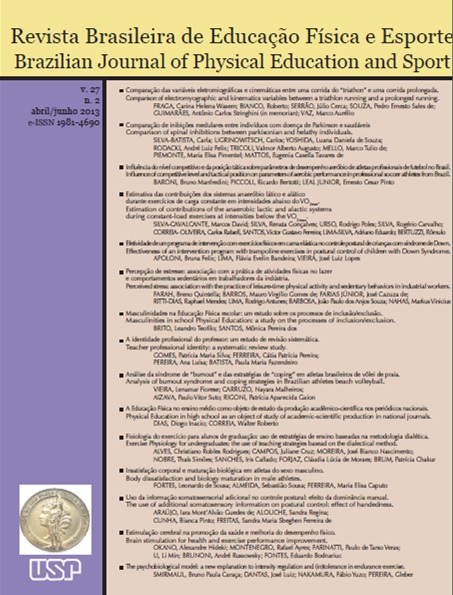Comparison of electromyographic and kinematics variables between a triathlon running and a prolonged running
DOI:
https://doi.org/10.1590/S1807-55092013005000006Keywords:
Running, Triathlon, Fatigue, Electromyography, KinematicsAbstract
Running and cycling executed with the same duration and intensity may produce different biomechanical and metabolical responses during a fatigue protocol due to the mechanical overload and technical specificity of each modality. The purpose of this study was to evaluate the fatigue effects resultant from a 10 km running, preceded by cycling or running, on the stride pattern and electromyographic (EMG) signal. Nine male triathletes with over two years of experience participated in the study. The tests were carried out in two phases: triathlon running (40 km of cycling followed by 10 km of running) and prolonged running (running with equal duration of time of the 40 km of cycling, followed by more 10 km of running). Kinematic analysis (stride frequency and amplitude) and EMG analysis were performed on ten strides recorded at the 5th km and at the 10th km (final running period). The EMG curves were rectified and filtered prior to the calculation of the RMS curves. From the average of the ten EMG curves, the peak RMS values for the following muscles were obtained: rectus femoris, vastus lateralis, biceps femoris. Higher stride frequency and EMG signals were obtained for biceps femoris muscle on the prolonged compared to the triathlon running. These results seem related to a higher fatigue in the prolonged running due to it's higher mechanical demands.Downloads
Download data is not yet available.
Downloads
Published
2013-06-01
Issue
Section
Biodinâmica
License
Todo o conteúdo da revista, exceto onde está identificado, está licenciado sob uma Licença Creative Commons (CC-BY)
How to Cite
Fraga, C. H. W., Bianco, R., Serrão, J. C., Souza, P. E. S. de, Amadio, A. C., Guimarães, A. C. S., & Vaz, M. A. (2013). Comparison of electromyographic and kinematics variables between a triathlon running and a prolonged running. Brazilian Journal of Physical Education and Sport, 27(2), 179-186. https://doi.org/10.1590/S1807-55092013005000006


